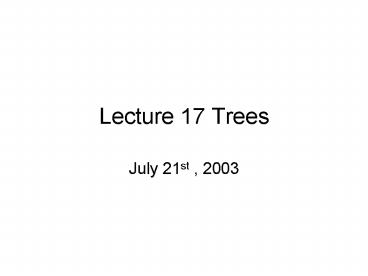Lecture 17 Trees - PowerPoint PPT Presentation
1 / 11
Title:
Lecture 17 Trees
Description:
(Pre- and Post- are 'opposites,' i.e. Ro-LR vs LR-Ro and 'In' puts Ro 'in-'side? ... Some properties of trees. A tree with n nodes has n-1 arcs ... – PowerPoint PPT presentation
Number of Views:32
Avg rating:3.0/5.0
Title: Lecture 17 Trees
1
Lecture 17 Trees
- July 21st , 2003
2
Tree--Definition
- A tree is an acyclic, connected graph with one
node designated as the root of the tree. - Special case
- nonrooted tree (free tree)
- Forest acyclic graph (not necessarily
connected) - Parent vs child(ren).
3
Definition (cont.)
- Depth
- Leaf
- Node
- Binary tree
- Full binary tree
- Complete binary tree (almost full).
4
Tree -- Applications
- In data structure
- Binary search tree
- 2-3 tree
- In file management
- Files in computer are organized in a tree-like
structure. - In biology
- Family tree
5
Creating EXPRESSION Tree
- Ex. 23 mentions the idea and shows an
- Expression Tree for
- (2 x) (y 3)
- --- MINUS is the ROOT node PLUS MULT
first-level below the root - and 2, x, y, 3 are the LEAVES
- Prax 19 p. 374 asks for an ExpTree for a
simpler case (2 3) 5 - --- When youve seen one Expressn Tree youve
seem em all ?
6
Binary tree representation
- Left child - right child rep --- TABLE (See lotsa
0,0 pairs!!) - Pointer representation --- Linked List (3-Slot
Elements) - Ex 24 p. 374-375 illustrates both these REPs
for a 3-level binary tree with one missing leaf
!! 1 ? 2, 3 2 ? 4, 5 3 ? 6 - Prax. 20 p. 375 illustrates both these REPs
for a 4-level tree which opens only to one side
(from the top node) - COMMENT on Prax 20 By writeg out the
solutions in the white space of the page where
Prax 20 is found, I thought it would be better to
FIRST do the POINTER rep and then follow it up
with Left-Child/Right-Child solution I
report-you decide The pointer rep. kinda
matches up with the drawing and helps identify
0 (or ) locations for the LChild-RChild Rep
7
Tree traversal algorithms
- Pre-order --- Root-Left-Right .. RoLtRt e-o
o-e - In-order --- Left-Root-Right.. LtRoRt
i-o e-o - Post-order --- Left-Right-Root.. LtRtRo o-o
e-i - (Pre- and Post- are opposites, i.e. Ro-LR vs
LR-Ro and In puts Ro in-side?) - A basic idea is a recursive view of a tree
- Subtrees are labelled as T1 , T2, ,Tt
8
A traversal algorithm
- ALGORITHM PREORDER
- Preorder (tree T)
- write (r)
- for i1 to t do
- Preorder(Ti)
- end for
- end Preorder
- Postorder merely shifts the write the for
loop (and changes names) - Inorder mimics Preorder mit an extra call on
Inorder(Ti) at the start also changeg the for
loop start to 2 - See non binary tree remarks on p. 378
9
Traversal--Examples
- Ex 25-27 p377 Ar puts ans. right above the
Tree for PRE-ORD (Root-LR) - a
- b
c - d e f
g - h
i - and then just lists (on the page below) the
solutions for INORD (L-Root-R, first, and POSTORD
(LR-Root) last - Prax 21- p. 378 does about the same thing (all 3
orders) - Can we rep. algebra expressions as binary trees?
Choices are given as - Get Infix notation from Inorder, uncoverg (2
x) 4 --- PARENS put in (How?) - Git Prefix notation (aka Polish notation) from
Preorder .. uncoverg 2 x 4 - Get Postfix notation (aka Reverse Polish)..
Uncoverg 2 x 4 - ? See a Pre- Post- convert to Infix (a
hint on how parens appear?) - b Pre- Post- DO NOT NEED PARENS
at all (SEMANTIC-wise) and - c They evaluate sequentially
mit NO LOOK-AHEADs for paren-exprs
10
Some properties of trees
- A tree with n nodes has n-1 arcs
- Any tree with n nodes, the total number of arc
ends is 2n-2. - A binary tree has at most 2d nodes at depth d.
- The number of leaves in any binary tree is 1 more
than the number of nodes with two children.
11
Exercise
- Exercises 5.2
- 3, 10,23, 28, 38, 40, 41































